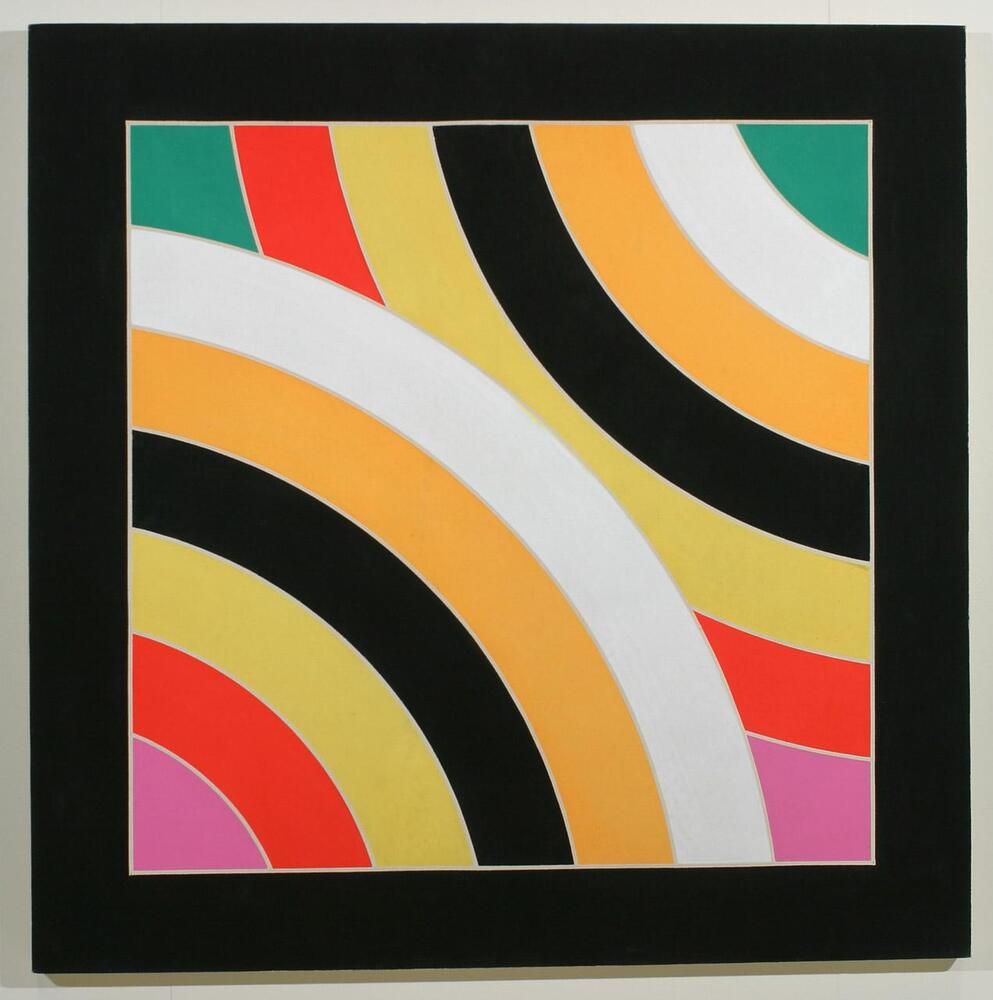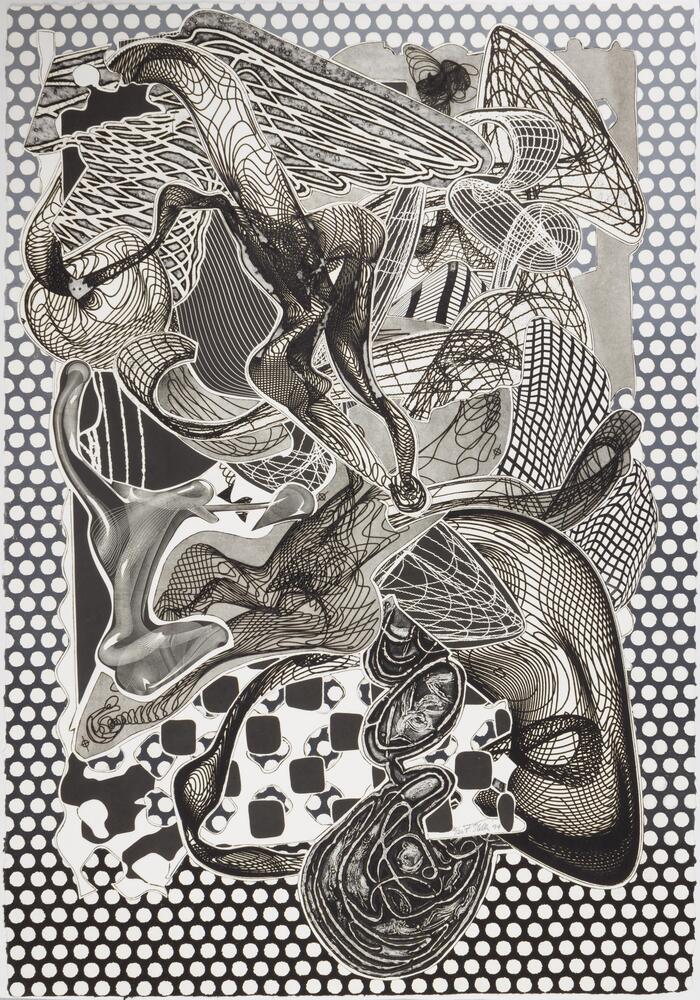Essay: Stella
Minimalism was developed in direct opposition to Abstract Expressionism, which was often highly emotional in content and execution. Minimalists believed that the physical materials and qualities of a work of art should be emphasized rather than its emotional associations or intellectual references. Minimalism is often characterized by geometric forms and machine like finishing.
Frank Stella is one of the most distinctive artists of this movement. Stella’s oft-quoted line “what you see is what you see” means that he, as an artist, can only do so much on a canvas. Essential to the work is the participation of the viewer.
Stella was the youngest of three children born to Sicilian immigrants. At Princeton University he studied art history (focusing on pre-Christian art) and art under Stephen Greene and William Seitz. He graduated in 1958 and moved to New York City.
In his earliest work, Stella painted loose, gestural abstractions following in the footsteps of the artists of the New York School. From here, he developed his own style: flat stripes with little to no painterly embellishment on unprimed canvas. By fall 1958, Stella began the Black Series, a series of twelve paintings that established his reputation. His first major sale was “The Marriage of Reason and Squalor” from this series.
At the beginning of the 1960’s, he continued the theme of single-color stripes, but also started working with “shaped” canvases, in which corners would be removed and edges would be sharply angled. Toward the middle of the decade, he started combining colors in his works (the Persian Series, 1964), but retained the shaped canvases. The Protractor series (1966-71), which UMMA’s Untitled, belongs to, used semicircular elements and juxtaposed colors initially inspired by his daughter’s 64-color Crayola crayon box.
UMMA’s Untitled is composed of an array of complementary colors of similar luminance. It is rare, but not unheard of, for one of Stella’s works to be untitled. The piece is alienating because of the almost mechanically precise forms and severe framing of this piece. Yet the bright colors and more curvilinear forms are more playful than many minimalist works of this period.
Stella’s works are plotted on graph paper before execution, usually in rough sketches. On the canvas itself, he works from points plotted using a bean compass, which he devised himself. After drawing the design with pencil on unsized canvas, Stella uses masking tape to delineate the areas of color. He then paints the areas with “fairly arbitrary” colors, and when the masking tape is pulled off, blank lines remain.
The paint is commercial acrylic paint, which he has used throughout his career. The brushstrokes are very flat, staining the canvas (the paint can be seen on the reverse side of the canvas). In this way Stella emphasizes the flatness of the painting’s surface and the “object” nature of the painting itself.
Stella’s more 3D work is sometimes akin to collage or relief. He incorporates unconventional materials. To this day, Stella refers to both his sculptures as “paintings,” because of the malleability of the materials and because he intends his works to be viewed frontally.
The painting itself is rather large and thick and doesn’t totally lie flat on the wall. Stella wants to expand the image beyond its surface. He plays with the dimensions of his paintings to add dimension. Consequently, the shadows on the wall cast by the painting may be considered part of the work as well.
Stella is an early adopter of CAD/CAM technology, and his print work especially reflects this. From 1984 to 1993, Stella created a number of prints that showed vector graphics and extensive 3D modeling. UMMA’s Riallaro (Black and White) is a fine example using both these techniques. Stella would often combine three or more printing techniques on a single print, giving the works a 3D quality.
Stella continues to live and work in New York City; he also has a studio in upstate New York.
Resources
UMMA’s collection database, Embark.
The Grove Dictionary of Art online
http://www.mirvish.com/OurTheatres/murals.html - Installation of a mural at the Princess of Wales Theatre, Toronto, Canada
http://www.youtube.com/watch?v=cN_rRCfRdmQ - Interview with Frank Stella, 1972.
“Frank Stella: Feel Art Again, 5/12/09” http://www.mentalfloss.com/blogs/archives/25467 - from the Mental Floss blog, this is a very short look at Stella’s art.
“Frank Stella Three Ways” http://findarticles.com/p/articles/mi_hb3345/is_10_25/ai_n29435053/ - Originally published in The New Criterion, June 2007
“A Vivid Back Story for a Stella Legend” http://www.nytimes.com/2006/02/10/arts/design/10stel.html
“Studying with Stella”
http://www.ns.umich.edu/MT/96/Win96/mta9w96.html - Stella was a visiting scholar in 1996 to U-M. Accessed 10/1/09
“Frank Stella Polychrome Relief”
http://www.paulkasmingallery.com/exhibitions/2009-10-01_frank-stella/press-release/ - Stella’s most recent exhibition at the Paul Kasmin Gallery. Accessed 2/9/10
“Frank Stella”
http://www.moma.org/collection/browse_results.php?criteria=O%3AAD%3AE%3A5640&page_number=2&template_id=6&sort_order=1 - An excellent short biography covering most aspects of his career. Accessed 2/9/10
Created For
K-12 EducatorK-12 Student
Museum Visitor
UMMA Docent
UMMA Staff
University Faculty
University Student
Rate this Resource
AVG: 0 | Ratings: 0
& Author Notes
Creative Commons by-nc-saLast Updated
April 12, 2018 11:23 a.m.Report
Reporting Policy


